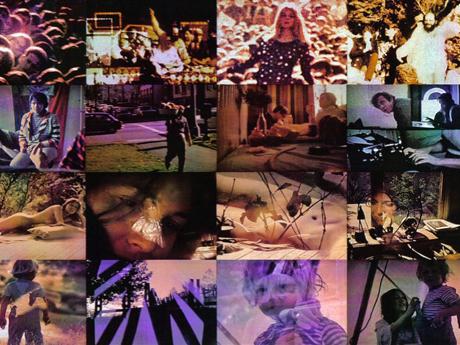
EUGENE, Ore. -- (February 19, 2013) – Eugene-raised film and video artist Loren Sears showcases his poetic documentaries “The Haight Ashbury Quartet” and “The Pacific Lake” on March 13 at 7 p.m. at the Jordan Schnitzer Museum of Art. Schnitzer Cinema screenings are free and include free popcorn and soda.
“The Haight Ashbury Quartet” is comprised of four short 16mm films that date from 1967 to 1971 and that utilize experimental techniques of superimposition and optical printing to portray private and communal life in San Francisco.
The first of the four, “Be In,” was made from found or borrowed footage and audio recordings from the original “Human Be In,” held in January 1967 in San Francisco’s Golden Gate Park. It was intended to deliver an authentic experience of being there, rather than document the event. “Tribal Home Movie #2” takes place in the spring of 1967, just prior to “The Summer of Love” and shows a view of the characters and environs in the heart of the Haight Ashbury community.
“Connie Joy” is a love poem on film. Made the day before Valentine’s Day in 1971, Sears composed images and sequences in the camera, using such techniques as triply exposing short segments, partially exposing different layers, and matting collaged images to create this three minute film. The “Quartet” ends with “Sevin Goes to School,” a companion piece to "Connie Joy," using the same in-camera multiple exposure techniques but documenting Connie’s five-year-old son’s first day of school in Sonoma County, California.
“Visual filmmaking differs from most narrative film forms and is more comparable to music, painting and poetry,” says Sears. “Visual experience relies on the whole sensorium of color, image, motion, sound and time rather than representational imagery and dialogue, and appeals to the emotional,-intuitive brain rather than the intellectual-rational brain.”
Sears will also screen “The Pacific Lake,” a 1973 video poem drawn from his West Coast journals of the Tribal Vision Network. The Tribal Vision Network was a van-based, portable video studio connecting new age communities of the West Coast, Sierras and Rocky Mountains, which Sears operated from 1971 to 1974, sharing their visions of cultural re-inhabitation. “The Pacific Lake” is a 25-minute edited composition from the Summer of 1972, Bolinas, California to the Canadian border.
“Working as a video artist, I have tried to understand how media affect our social and personal psychology,” says Sears. “I regard television and other media as a kind of blood stream nutrition circulating through our collective body. Consequently, the wellness and integrity of the body is highly influenced by what we put in it.”
Sears has been an artist in residence and directed programs for KQED-TV, San Francisco; produced numerous community-oriented public access programs; was the founding production manager of KLSR-TV, a Fox affiliate in Eugene, OR, where he produced and directed numerous news, public interest programs and local commercials; produced a pilot for Oregon Public Broadcasting in 2000 called "Oregon Gazette;" and served three years on the OPB Community Advisory Board.
He has taught filmmaking at San Francisco Art Institute and University of California San Francisco Extension; video at Evergreen State College, Olympia, WA; and has had one-man shows at Canyon Cinematheque, San Francisco, Yale University, Philadelphia College of Art, Secret Cinema, London, England, and the Huntington Hartford Museum, NY. His films are in the collections of the Whitney Museum of American Art New American Cinema and in the Rock and Roll Hall of Fame, in Cleveland, OH.
Cosponsored with the Cinema Pacific film festival, Schnitzer Cinema is the JSMA's monthly showcase for adventurous cinema, featuring screenings and live presentations or Skype dialogues with special guests. This season’s programs complement the JSMA exhibition “West of Center: Art and the Counterculture Experiment in America, 1965-1977,” on view through April 28. Films will be screened in the Jordan Schnitzer Museum of Art Ford Lecture Hall and start at 7 p.m.
About the Jordan Schnitzer Museum of Art
The University of Oregon's Jordan Schnitzer Museum of Art is a premier Pacific Northwest museum for exhibitions and collections of historic and contemporary art based in a major university setting. The mission of the museum is to enhance the University of Oregon’s academic mission and to further the appreciation and enjoyment of the visual arts for the general public. The JSMA features significant collections galleries devoted to art from China, Japan, Korea, America and elsewhere as well as changing special exhibition galleries. The JSMA is one of six museums in Oregon accredited by the American Association of Museums.
The Jordan Schnitzer Museum of Art is located on the University of Oregon campus at 1430 Johnson Lane. Museum hours are 11 a.m. to 8 p.m. Wednesdays, and 11 a.m. to 5 p.m. Tuesdays and Thursdays through Sundays. Admission is $5 for adults and $3 for senior citizens. Free admission is given to ages 18 and under, JSMA members, college students with ID, and University of Oregon faculty, staff and students. For information, contact the JSMA, 541-346-3027.
About the University of Oregon
The University of Oregon is among the 108 institutions chosen from 4,633 U.S. universities for top-tier designation of "Very High Research Activity" in the 2010 Carnegie Classification of Institutions of Higher Education. The UO also is one of two Pacific Northwest members of the Association of American Universities.
Contact: Debbie Williamson Smith, 541-346-0942, debbiews@uoregon.edu
Links: Jordan Schnitzer Museum of Art, http://jsma.uoregon.edu
Cinema Pacific, http://cinemapacific.uoregon.edu/
- Log in to post comments






